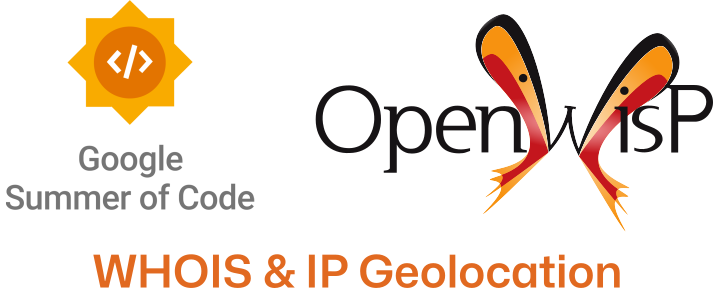GSoC 2025: WHOIS Info and Estimated Geographic Locations
Published on by Aman Jagotra
Category: gsoc
Tags: gsoc controller whois ip new-features

This summer has been one of the most rewarding experiences of my journey as a developer. Over the past three months, I worked on my Google Summer of Code project under the mentorship of Federico Capoano (nemesifier), Sankalp (codesankalp) and Kapil Bansal (devkapilbansal). The journey was filled with challenges, creative problem-solving, and exciting breakthroughs that significantly enhanced both my technical and collaborative skills.
About the Project
The WHOIS Information and IP Address-Based Geolocation Module enhances OpenWISP by enriching device metadata with ownership details and approximate geographic location whenever a new public IP address is reported. This feature helps administrators improve network visibility, identify anomalies, and streamline troubleshooting by providing context about IP addresses directly within the OpenWISP platform.
For further details on these features and their functionality within OpenWISP, see the documentation pages listed here (the links below temporarily reference GitHub RST files and will be updated to the official documentation once merged in master):
Building WHOIS and IP Geolocation Functionality
My work involved tracking the IP addresses reported by devices and using it to fetch WHOIS information which included details like organization name, ASN, and location details. Using the location details obtained, a location linked to the device must be created with clear indication of its estimated nature.
Technical Approach
To fetch WHOIS information, I used geoip2 web service to obtain the necessary details. While django provides built-in support for geoip2, at the time of writing this, it supports only database based approach (which we will target in the future) and also has limited fields available (see: https://docs.djangoproject.com/en/5.2/ref/contrib/gis/geoip2/).
I also kept all the related code inside a single folder (config/whois and geo/estimated-location) to ensure flexibility, modularity and maintainability while also following existing directory and coding standards.
Features Implemented
WHOIS Lookup

WHOIS is a widely used protocol that provides publicly available registration details of IP addresses and domain names. It helps identify the organization or individual that owns an IP address, along with related information such as the organization name, ASN (Autonomous System Number), CIDR block, etc. This data is crucial for network management, security auditing, and diagnostics.
To perform a WHOIS lookup, the last reported IP address of a device is tracked for changes. When a change is detected, the system performs all the necessary checks and fetches asynchronously the WHOIS information related to the new IP. Fetched details include organization name, ASN, CIDR block, physical address, coordinates and timezone. Since the linking of device and WHOIS record is via ip_address, data redundancy is minimized.
Functional Highlights:
- Global Configuration: The feature can be configured globally as well as for individual organizations.
- Asynchronous Lookup: The lookup is done in background asynchronously to avoid blocking the main application flow.
- Up-to-date WHOIS Information: The system periodically refreshes WHOIS information to ensure it remains current and accurate.
- Dedicated Admin Section: WHOIS details are displayed alongside last_ip in the device admin page for easy access.
- REST API: WHOIS information is included in both device list and detail endpoints for API consumers.
Related Work:
Estimated Location

IP-based geolocation estimates the physical location of a device using its public IP address. This is achieved by querying reliable IP geolocation databases that map IP ranges to real-world locations. The information retrieved typically includes country, region, city, coordinates, and sometimes the ISP. While not as precise as GPS, it is highly useful for network monitoring, compliance, and detecting anomalies such as devices connecting from unexpected regions.
Creation of estimated location for the device is done after performing WHOIS lookup since location related information (coordinates and address) is fetched as part of it.
Functional Highlights:
- Global Configuration: The feature can be configured globally as well as for individual organizations.
- Asynchronous Management: The creation/update of an estimated location is done in background asynchronously to avoid blocking the main application flow.
- Clear Indicators and status update: Estimated locations are flagged in the admin for manual review, and the status is cleared automatically when the address or geometry is updated.
- User alerts: Dispatch web notifications for modifications in estimated location.
- REST API: Estimated Status is included in all location related API endpoints like location list/detail, device locations etc. The field can also be used for filtering results.
Related Work:
Current state
We are maintaining the gsoc25-whois branch as parent branch for all the WHOIS and IP geolocation features. Once all the PRs are merged and features are tested and validated, we can proceed with releasing these along with OpenWISP 26.
All the WHOIS feature related PRs are merged to the gsoc25-whois branch except Updating stale WHOIS records #1116 which is pending review.
The Estimated location feature related PRs Estimated Location Creation #1067 and Estimated Location: Admin and API filters #1109 are also pending review.
My Experience
My GSoC journey with OpenWISP was an enriching experience that enhanced my technical and collaborative skills. I worked closely with an amazing community and mentors who provided constant guidance, insightful feedback, and encouraged best practices throughout the program.
During this period, I gained hands-on experience with modern technologies and development practices, including writing efficient, reusable code, implementing automated tests, and improving software reliability through iterative development. I also learned the importance of database optimization, caching strategies, and integration testing, which deepened my understanding of building scalable applications.
Beyond coding, I experienced the true essence of open-source collaboration, engaging with the community, understanding real-world use cases, and working in an environment where continuous feedback leads to better solutions. This journey strengthened my ability to adapt, troubleshoot, and deliver high-quality contributions.
What's Next?
As my GSoC journey comes to an end, I’m looking forward to building on the foundation we’ve created. There are several enhancements planned to make these features even more powerful and user-friendly, such as:
- Database-based WHOIS Lookup: Adding support for MaxMind databases to improve lookup speed and reliability with mechanisms to keep them updated without manual effort.
- SSID-based Geolocation: Implementing a feature to determine the device's location based on nearby Wi-Fi SSIDs, leveraging external services (e.g. Google) for more accurate results.
Beyond these improvements, user feedback will play a key role in identifying bugs, edge cases, and areas for refinement, helping us make the features more robust over time.
I plan to keep contributing actively to OpenWISP, working on bug fixes, adding new enhancements, and supporting new contributors in their open-source journey. Now that I have an in-depth understanding of the OpenWISP codebase, I’m also interested in maintaining and evolving the features I developed during GSoC.